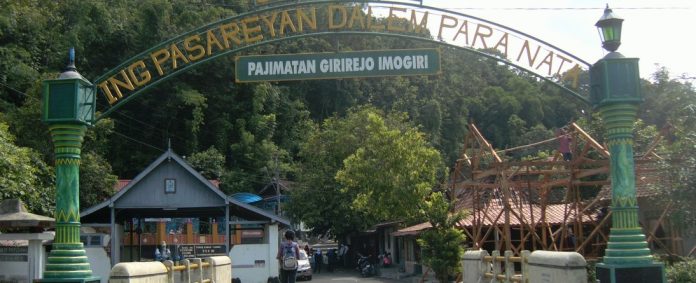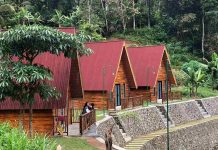The Mataram’s Royal Cemetery or more famous as The Imogiri Royal Cemetery was built in 1632–1640 by Sultan Agung Adi Prabu Hanyokrokusumo as the third Sultan of Mataram from the descendants of Panembahan Senopati who is the first Mataram King. Imogiri Royal Cemetery is located in Girirejo Imogiri, Bantul. This is a complex of cemetery for king and royal families.
Pajimatan Girirejo or the process to decide hills to build a king’s cemetery has a previous history. According to stories from the local, when Sultan Agung was looking for land to be used as a special burial place for the sultan and his family, he threw a handful of sand from Arabia. After the sand was thrown far away, it finally landed on the Imogiri hills. Therefore, the Sultan ordered the construction of the cemetery to be carried out in Imogiri. So that in 1632, an architect named Kyai Tumenggung Tjitrokoesoemo began building a cemetery. After 13 years, Sultan Agung died and was buried in Imogiri.

The Mataram kingdom reached its glory during the reign of Sultan Agung because it was able to take control almost all of the land of Java. During his reign, he fought against the Dutch. In 1628 and 1629, Mataram attacked the VOC headquarters in Batavia, but they failed. According to the story, this failure was due to a retainer in Mataram who had previously leaked the plan to attack the Dutch. The Mataram retainer according to the story was Tumenggung Endranata who was also buried in the Imogiri Cemetery.
This betrayal caused the Dutch burnt down the logistical places of rice barns in preparation for the Mataram troop to Batavia so that the Mataram troops were easily defeated. Finally, Sultan Agung knew of a betrayal by one of his troops. Sultan Agung then took action by arresting and executing Tumenggung Endranata. Then the traitor’s head was beheaded, and the headless body was planted in one of the stairs. It’s under the cemetery gate.
The pilgrims can find the traitor’s grave in the form of an elongated stone staircase. These steps are a warning to others so that there is no more betrayal.
When entering the cemetery area, you will immediately smell of flowers mixed with incense. Every day, the courtiers put special offerings at the cemetery. According to the caretaker of the Imogiri Cemetery, the cemetery of Sultan Agung always emits a fragrant aroma because of he is already as the guardian of Allah.
Until now, the cemetery of Sultan Agung is very sacred so that not anyone can enter the cemetery complex. For pilgrims who are going to make the pilgrimage, there are requirements that must be fulfilled, such as pilgrims must wear Javanese or peranakan clothes (for male pilgrims must wear Javanese clothes in the form of blangkon, beskap, cloth, belt, timang and samir, while for female pilgrims it must be wearing kemben and long cloth), it is prohibited to wear footwear, jewellery, especially gold, and bring a camera.
In the grave area, visitors are prohibited from being rude, cutting trees, uprooting or destroying crops, hunting, and taking wood.

In addition, visitors can also see the four barrels or padhasan which according to the story is an offering from the the kingdom of friends to Sultan Agung. These barrels have different names, namely Gentong Nyai Siyem from Siam, Gentong Kyai Mendung from Rum or Turkey, Gentong Kyai Danumaya from Aceh, and Gentong Nyai Danumurti from Pelembang. The barrels are said to have certain properties such as for health, healing or success so that many believing pilgrims are scrambling to get water from these barrels.
The Imogiri cemetery is open every day, however on certain days such as Friday Kliwon and Tuesday Kliwon nights, this cemetery will be filled of many visitors. The pilgrims who come for doing the ritual prayers around the cemetery, especially at midnight. The pilgrims come with their own goals, such as praying for wealth, career, success, or kanuragan skill, etc.
To visit the king’s cemetery in Imogiri, you can use a private car or bus. From Giwangan bus station take the Yogyakarta-Panggang bus or Yogyakarta Petoyan route. Arriving at the Imogiri bus station, visitors only need to walk about 250 meters to the stairs heading to the cemetery.
There is free of charge to visit the king’s grave in Imogiri cemetery. But, every visitor is required to fill in the guest book and give a voluntary fee to the caretaker of the cemetery. If visitors also bring water from the barrel, an additional fee will also be required in voluntary.
The facilities here are quite complete, there are parking area, public toilets and a guide that will tell you the history related to the Imogiri Royal cemetery. Visitors can also buy three booklets as photocopies containing the history of the cemetery of the King of Mataram, the scheme of the king’s grave and the history mataram in Kotagede. There are also several stalls food at the Imogiri bus station that sell various foods and drinks such as wedang uwuh, pecel (vegetables with peanut sauce), jadah tempeh and bacem tofu.




